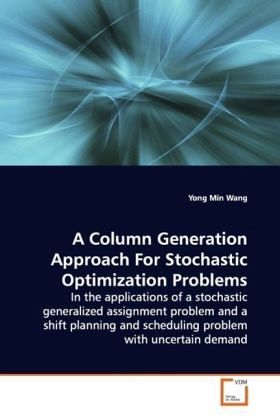
A Column Generation Approach For Stochastic Optimization Problems
In the applications of a stochastic generalized assignment problem and a shift planning and scheduling problem with uncertain demand
Versandkostenfrei!
Versandfertig in 6-10 Tagen
39,99 €
inkl. MwSt.

PAYBACK Punkte
20 °P sammeln!
Understanding how uncertainty effects the dynamics and behavior of an organization is a critical aspect of system design. Models and methods that take uncertainty into account can lead to significant reductions in cost. This book investigates the use of stochastic optimization models for a generalized assignment problem (GAP) with uncertain resource capacity and a shift planning and scheduling problem (SPSP) with unknown demand. For the GAP, the first stage decisions correspond to an assignment of jobs to agents. Penalties are incurred when the assignments do not permit all demand to be satisf...
Understanding how uncertainty effects the dynamics
and behavior of an organization is a critical aspect
of system design. Models and methods that take
uncertainty into account can lead to significant
reductions in cost. This book investigates the use
of stochastic optimization models for a generalized
assignment problem (GAP) with uncertain resource
capacity and a shift planning and scheduling problem
(SPSP) with unknown demand. For the GAP, the first
stage decisions correspond to an assignment of jobs
to agents. Penalties are incurred when the
assignments do not permit all demand to be
satisfied. For the SPSP, the number of full-time and
part-time employees, as well as the number of full-
time shifts by type, must be specified before the
demand is known. In the second stage, feasibility is
addressed by allocating overtime and calling in
temporary workers to handle spikes in the mail
volume. This book contains the development and
analysis of stochastic integer models for the GAP
and the SPSP and the estimation of the demand
distributions from historical data. To solve the
associated stochastic integer problems, the column
generation algorithms are developed.
and behavior of an organization is a critical aspect
of system design. Models and methods that take
uncertainty into account can lead to significant
reductions in cost. This book investigates the use
of stochastic optimization models for a generalized
assignment problem (GAP) with uncertain resource
capacity and a shift planning and scheduling problem
(SPSP) with unknown demand. For the GAP, the first
stage decisions correspond to an assignment of jobs
to agents. Penalties are incurred when the
assignments do not permit all demand to be
satisfied. For the SPSP, the number of full-time and
part-time employees, as well as the number of full-
time shifts by type, must be specified before the
demand is known. In the second stage, feasibility is
addressed by allocating overtime and calling in
temporary workers to handle spikes in the mail
volume. This book contains the development and
analysis of stochastic integer models for the GAP
and the SPSP and the estimation of the demand
distributions from historical data. To solve the
associated stochastic integer problems, the column
generation algorithms are developed.












